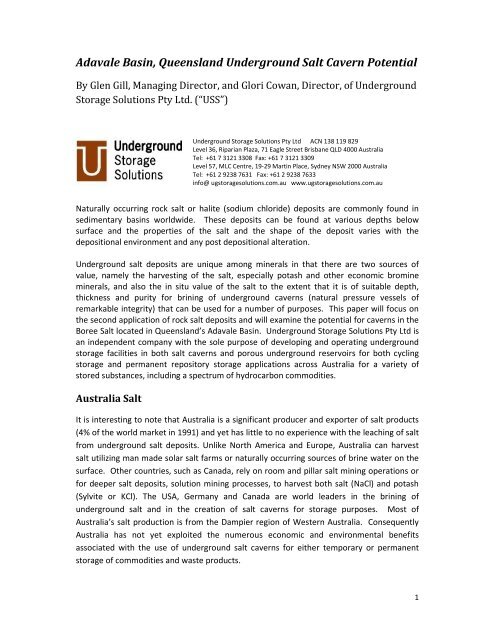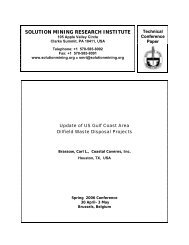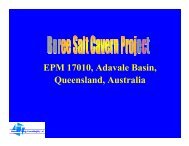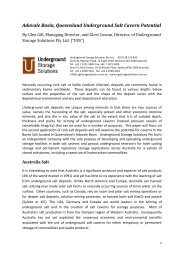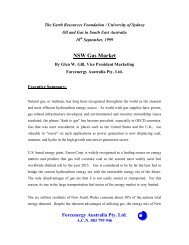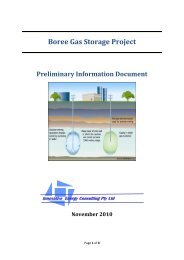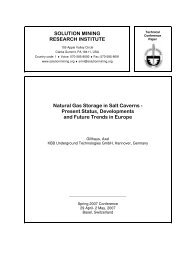Mining Journal - Innovative Energy Consulting - Brisbane, Australia
Mining Journal - Innovative Energy Consulting - Brisbane, Australia
Mining Journal - Innovative Energy Consulting - Brisbane, Australia
You also want an ePaper? Increase the reach of your titles
YUMPU automatically turns print PDFs into web optimized ePapers that Google loves.
Adavale Basin, Queensland Underground Salt Cavern Potential<br />
By Glen Gill, Managing Director, and Glori Cowan, Director, of Underground<br />
Storage Solutions Pty Ltd. (“USS”)<br />
Underground Storage Solutions Pty Ltd ACN 138 119 829<br />
Level 36, Riparian Plaza, 71 Eagle Street <strong>Brisbane</strong> QLD 4000 <strong>Australia</strong><br />
Tel: +61 7 3121 3308 Fax: +61 7 3121 3309<br />
Level 57, MLC Centre, 19-29 Martin Place, Sydney NSW 2000 <strong>Australia</strong><br />
Tel: +61 2 9238 7631 Fax: +61 2 9238 7633<br />
info@ ugstoragesolutions.com.au www.ugstoragesolutions.com.au<br />
Naturally occurring rock salt or halite (sodium chloride) deposits are commonly found in<br />
sedimentary basins worldwide. These deposits can be found at various depths below<br />
surface and the properties of the salt and the shape of the deposit varies with the<br />
depositional environment and any post depositional alteration.<br />
Underground salt deposits are unique among minerals in that there are two sources of<br />
value, namely the harvesting of the salt, especially potash and other economic bromine<br />
minerals, and also the in situ value of the salt to the extent that it is of suitable depth,<br />
thickness and purity for brining of underground caverns (natural pressure vessels of<br />
remarkable integrity) that can be used for a number of purposes. This paper will focus on<br />
the second application of rock salt deposits and will examine the potential for caverns in the<br />
Boree Salt located in Queensland’s Adavale Basin. Underground Storage Solutions Pty Ltd is<br />
an independent company with the sole purpose of developing and operating underground<br />
storage facilities in both salt caverns and porous underground reservoirs for both cycling<br />
storage and permanent repository storage applications across <strong>Australia</strong> for a variety of<br />
stored substances, including a spectrum of hydrocarbon commodities.<br />
<strong>Australia</strong> Salt<br />
It is interesting to note that <strong>Australia</strong> is a significant producer and exporter of salt products<br />
(4% of the world market in 1991) and yet has little to no experience with the leaching of salt<br />
from underground salt deposits. Unlike North America and Europe, <strong>Australia</strong> can harvest<br />
salt utilizing man made solar salt farms or naturally occurring sources of brine water on the<br />
surface. Other countries, such as Canada, rely on room and pillar salt mining operations or<br />
for deeper salt deposits, solution mining processes, to harvest both salt (NaCl) and potash<br />
(Sylvite or KCl). The USA, Germany and Canada are world leaders in the brining of<br />
underground salt and in the creation of salt caverns for storage purposes. Most of<br />
<strong>Australia</strong>’s salt production is from the Dampier region of Western <strong>Australia</strong>. Consequently<br />
<strong>Australia</strong> has not yet exploited the numerous economic and environmental benefits<br />
associated with the use of underground salt caverns for either temporary or permanent<br />
storage of commodities and waste products.<br />
1
The Adavale Basin in Queensland and the Canning Basin in Western <strong>Australia</strong> and possibly<br />
the Officer Basin in South <strong>Australia</strong> appear to offer the best salt deposits in <strong>Australia</strong> for the<br />
development and operation of salt cavern storage facilities.<br />
Background on Various Categories of Salt Deposits<br />
The simplest geometrical form of salt is that of relatively flat lying salt beds which have not<br />
undergone many post-sedimentary changes in thickness. These bedded salt deposits can be<br />
of very large areal extent (e.g. the Prairie Evaporite bedded salt in Canada’s Western<br />
Canadian Sedimentary Basin). Other salt structures such as pillows or domes are formed by<br />
precipitation of salt from ancient seas formed from originally bedded salt that has migrated<br />
laterally and flowed upwards.<br />
While bedded salt tends to be found in relatively thin layers interspersed with layers of<br />
shale and other materials, dome salt tends to be very thick and homogenous. For example<br />
it is not uncommon to find salt domes in the Gulf of Mexico region of the USA and in the<br />
Provinces of Nova Scotia and Ontario, Canada that are in excess of 6,000 m thick with<br />
considerable areal extent.<br />
The large structures which develop as a result of the extremely slow process<br />
of salt diapirism are classified morphologically. Salt pillows are masses of<br />
salt accumulated by lateral salt movement which have not yet pierced the<br />
cover rock. Salt domes are those salt structures which have pierced the<br />
surrounding sediments (piercement structures). The upward movement of<br />
salt masses can be divided into two to three stages according to the<br />
conventional models<br />
1.) Formation of pillows / start of salt migration (Pre-piercement stage):<br />
When salt migration starts, rounded to elongate updoming takes place on<br />
the surface of the salt to form isometric salt pillows, symmetrically<br />
elongated salt ridges, salt swells or anticlines, and very asymmetrical salt<br />
rollers.<br />
2 a.) Formation of salt domes or salt walls (Piercement stage):<br />
During the main salt migration phase, an increase in the vertical movement<br />
rate starting from the initial updomed zones gives rise to the formation of<br />
individual salt domes and salt diapirs or very elongate salt walls. All of these<br />
have steep sides which not only lift up but also destroy and pierce overlying<br />
stratigraphic units. After the initially horizontal and then diagonal and<br />
subsequently mainly vertical movement of the salt giving rise to the<br />
formation of the actual salt dome (bulb), a usually cylindrical stem develops<br />
which is surrounded by a ring-shaped zone of subsidence called the rim<br />
syncline. The lateral expansion of the bulb of the salt dome gives rise to the<br />
development of the typical pear-shaped cross section. (Refer to Figure 1.0)<br />
2 b.) Development of the salt dome with overhangs and/or detachments<br />
(Postpiercement stage):<br />
2
The main salt migration phase can be followed by a maturation phase in<br />
which the salt diapir spreads out at the top to form the typical mushroomshaped<br />
cross section. The lateral extension of the salt can also take the form<br />
of relatively thin salt tongues. The continuous supply of salt in the stem of<br />
the salt diapirs usually leads to the dragging and bending of the outer<br />
margins of the salt tongues giving rise to the development of wedge-shaped<br />
dipping salt overhangs. At the mature stage, the central stem can become so<br />
thin that the upper part of the salt dome becomes completely detached<br />
from the deeper salt beds (detached salt diapir) to create a rootless salt<br />
dome. When the salt tongues of various salt domes grow together, they are<br />
called a salt canopy. 1<br />
Figure 1.0 Simplified Classification of Salt Deposits<br />
Source: Solution <strong>Mining</strong> Research Institute & KBB Underground Technologies<br />
Salt Cavern Storage Background<br />
Solution mined storage and production caverns or grottos exist today in salt structures at<br />
various depths below ground and with different characteristics and shapes worldwide.<br />
Salt has several properties that make it ideal for gas storage. It has moderately<br />
high strength and flows plastically to close fractures that could otherwise<br />
become leaks. Its porosity and permeability to liquid and gaseous hydrocarbons<br />
1 A Gillhaus and P. Horvath, KBB Underground Technologies, Solution <strong>Mining</strong> Research Institute Research<br />
Project No. 2007-1-SMRI: “Compilation of geological and geotechnical data of worldwide domal salt deposits<br />
and domal salt cavern fields”, pages 18 & 19.<br />
3
are near zero, so stored gas cannot escape. Salt caverns provide high<br />
deliverability; gas can be withdrawn quickly because there is no pressure loss<br />
from flow through pores. Cavern storage can cycle – switch from injection to<br />
production – in a matter of minutes, and contains a large fraction of working gas<br />
relative to total gas. Salt caverns are the preferred option for merchant storage,<br />
because they allow frequent cycling and high rates of injection and production. 2<br />
Caverns are located in salt formations which ideally are as homogenous as possible and<br />
which are very thick (e.g. thick bedded salt, salt pillow, salt dome) although there are many<br />
caverns in thin and more or less impure evaporite sequences (e. g. thin bedded salt, salt in<br />
tectonic nappes). 3 Domal salt cavern storage is far superior to bedded salt cavern storage<br />
but the domal salt deposits are much rarer than bedded salt. Consequently countries with<br />
domal salt deposits at depths below ground level from 400 m to 2,000 m are fortunate since<br />
the benefits of domal salt cavern underground storage having numerous applications are<br />
well documented and appreciated.<br />
Salt Caverns basically constitute very large underground openings that<br />
provide secure containment for materials that do not dissolve salt. In<br />
general, uses of salt caverns can be classified as either storage or disposal<br />
operations. Storage of liquid and gaseous hydrocarbons, and associated<br />
products, was successful early on, and remains the main use of salt caverns<br />
today. Disposal of wastes and “by-product” constitutes the next most<br />
important use of salt caverns. 4<br />
Salt caverns are solution mined via wells drilled into salt formations (bedded salts or salt<br />
domes) of sufficient thicknesses at depths of up to 2,000 m below ground level. Cavern<br />
dimensions can be up to 600 m in height and 60 to 100 m in diameter. Salt cavern volumes<br />
are larger for liquid storage than for gas storage and are generally in a range of between<br />
500,000 to 800,000 m³. A 10:1 ratio of height to span is considered to be optimal. The<br />
design and leaching of salt caverns to create a high quality underground pressure vessel is<br />
well established and is considerably less complex in dome salt formations compared to<br />
bedded salt formations. The supply of water for leaching and the disposal of the resultant<br />
brine often present a challenge, for the total quality of water required to leach a cavern in a<br />
salt formation is 7 to 10 times the cavern volume. The operation of salt cavern storage for a<br />
variety of storage purposes and cycling conditions has evolved over the past 50 years to that<br />
of an extremely safe and environmentally benign nature.<br />
The following figure 2.0 illustrates the known salt deposits worldwide and distinguishes<br />
between bedded and the higher value domal salt deposits.<br />
2 Numerous authors from around the world, Oilfield Review article, “Storing Natural Gas Underground”,<br />
Summer 2002, page 4.<br />
3 A Gillhaus and P. Horvath, KBB Underground Technologies, Solution <strong>Mining</strong> Research Institute Research<br />
Project No. 2007-1-SMRI: “Compilation of geological and geotechnical data of worldwide domal salt deposits<br />
and domal salt cavern fields”, page 21.<br />
4 R. L. Thomas and R. M. Gehle, AGM Inc., “A Brief History of Salt Cavern Use”, page 2.<br />
4
Figure 2.0 Major World Salt Deposits<br />
Source: Solution <strong>Mining</strong> Research Institute<br />
Although <strong>Australia</strong> has yet to exploit any of its onshore underground salt deposits through<br />
the development of underground storage facilities that enable either the temporary or<br />
permanent storage of gases, liquids, or solid wastes, the technical and economic viability of<br />
such facilities has been proven in many parts of the world, especially North America and<br />
Europe. Caverns dissolved in salt have been used for decades in various parts of the world<br />
to store hydrocarbons (oil, natural gas, ethane, propane…) and non-aqueous fluid products<br />
(e.g. ethylene glycol). The use of solution mined salt caverns for the storage of both liquids<br />
and gases is believed to have been first conceived in Canada in the early 1940’s and the<br />
storage of liquid hydrocarbons in salt caverns first occurred in Keystone, Texas, USA in 1950<br />
and spread rapidly in the early 1950’s in North America and several European countries.<br />
“Salt caverns engineered for gas storage were constructed in 1963 in Saskatchewan,<br />
Canada, at a depth of 3,700 ft (1,128 m). This was followed in the U.S. in 1970 by completion<br />
of two gas caverns in the Eminence Dome, Mississippi, at depth of 5,700 to 6,700 ft (1,737<br />
to 2,042 m). In France, gas storage in salt began in 1970 at Tersanne, at depth of<br />
approximately 1,400 to 1,500+ m (4,593 to 4,921 ft). Gas storage in the salt dome Honigsee,<br />
near Kiel, Germany, began in 1971 at depth of 1,307 to 1,335 m (4,288 to 4,380 ft)”. 5<br />
Thousands of salt caverns have been created throughout North America in both bedded and<br />
domal salt deposits for either cycling storage or permanent repository purposes for a variety<br />
of substances. The storage capacity of such caverns range in size from 1,000 to 50,000,000<br />
barrels per cavern for liquid storage and from 1 to 10 PJ’s of working gas per cavern for gas<br />
storage. There are currently over 2,000 salt caverns in North America used for the storage<br />
5 R. L. Thomas and R. M. Gehle, AGM Inc., “A Brief History of Salt Cavern Use”, page 3.<br />
5
of hydrocarbons. The first leached storage cavern in dome salt occurred in 1970 at<br />
Eminence, Mississippi, USA for the purposes of gas storage.<br />
As of the end of 2006 Germany had by far the most salt cavern storage facilities in Europe<br />
with over 260 salt caverns used for the storage of oil, gas and waste of which over 150 of<br />
these caverns are in salt domes – 49 used for gas storage and 98 used for strategic oil<br />
reserve storage. The first salt cavern developed in Germany for storage purposes was<br />
commissioned in 1963 and the first salt cavern developed for gas storage in Germany was<br />
commissioned in 1971.<br />
Diapiric salt structures are formed within three major sedimentary basins in Canada but are<br />
not found in the well known and vast Western Canadian Sedimentary Basin that covers<br />
Alberta, northeast British Columbia and most of Saskatchewan. Domal salt cavern storage is<br />
therefore not common in Canada although hundreds of much smaller bedded salt caverns<br />
are used for the storage of oil, NGL’s, LPG’s gas, petrochemicals and non-hazardous wastes<br />
in Canada. Underground rock salt deposits are widely distributed within the United States<br />
and are known in 25 of the 50 states. Some of the deposits are extensive and rank among<br />
the greatest salt deposits of the world, but the Gulf Coast basin is the only one containing<br />
salt domes. 6 As of 2008 Texas alone had 484 salt caverns used for storage purposes, most<br />
of which are located in dome salt deposits.<br />
Solution-mined caverns have been used for liquid-petroleum gas storage in<br />
Texas since the 1950’s. Currently there are 47 active underground<br />
hydrocarbon facilities in both, bedded and domal salt. These facilities have a<br />
combined total of 456 active caverns and a total of 530 wells. According to<br />
ROHAN & GRAY (2002) there are 79 onshore salt domes in Texas and there<br />
are 310 caverns leached in 23 salt domes (GINN 2002). Stored products<br />
include liquid petroleum gas, natural gas and crude oil (SENI 1988) although<br />
the majority of facilities and wells store liquefied petroleum gas. According<br />
to GINN (2002) there are eight active brine mining facilities in southeast<br />
Texas (fig. 6.2.2-3). Brine mining wells in southeast Texas primarily produce<br />
brine for chemical and petrochemical industries. Three facilities are<br />
permitted to dispose of oil and gas waste into caverns in domal salt in east<br />
or southeast Texas. 7<br />
Boree Salt, Adavale Basin, Queensland<br />
The Boree Salt deposit found extensively in the Adavale Basin, Queensland is one of five<br />
major onshore salt deposits known to exist in <strong>Australia</strong> (Refer to Figure 2.0). Underground<br />
salt deposits are typically discovered and mapped from information obtained via petroleum<br />
drilling activity and there exists a general lack of petroleum exploration in a number of<br />
6 A Gillhaus and P. Horvath, KBB Underground Technologies, Solution <strong>Mining</strong> Research Institute Research<br />
Project No. 2007-1-SMRI: “Compilation of geological and geotechnical data of worldwide domal salt deposits<br />
and domal salt cavern fields”, page 45.<br />
7 A Gillhaus and P. Horvath, KBB Underground Technologies, Solution <strong>Mining</strong> Research Institute Research<br />
Project No. 2007-1-SMRI: “Compilation of geological and geotechnical data of worldwide domal salt deposits<br />
and domal salt cavern fields”, page 49.<br />
6
onshore geological basins across <strong>Australia</strong>. The Boree Salt is a combination of bedded salt<br />
and pillowed salt deposits of the Devonian period in the Paleozoic era (Refer to Figure 3.0).<br />
It is important to note that the salt deposits in <strong>Australia</strong> are generally much older than those<br />
found in other regions worldwide and therefore often have been significantly altered.<br />
Figure 3.0 Simplified Geological Time Scale & Age of Worldwide Salt Basins<br />
Source: KBB Underground Technologies<br />
Geological Overview<br />
The Devonian aged Boree Salt Member is restricted to the eastern edge of the Adavale Basin<br />
on the western side of the large Pleasant Creek Arch. It is present as a thick arcuate wedge<br />
along the extent of the Warrego fault which parallels the Pleasant Creek Arch. Prior to Boree<br />
Salt precipitation the Bury Limestone was deposited during shallow marine conditions.<br />
Thrusting along the Warrego Fault resulted in these marine conditions becoming more<br />
restricted and the Boree Salt was precipitated as a bedded salt deposit under conditions of<br />
saline reflux. The Boree salt grades shoreward in a westerly direction into dolomites of the<br />
Cooladdi Dolomite. The northern edge of the salt body is demarcated by the subcropping of<br />
the salt. In a southward direction the salt is continually evident and appears at ever<br />
increasing depths within the eastern edge of the Adavale trough. The Boree Salt Member<br />
reaches thicknesses of over 500m and extends for over 100 kilometres along the Pleasant<br />
Creek Arch. Compositionally, the Boree Salt Member is mainly halite with purities of > 90%<br />
being recorded. In addition to halite the member contains minor amounts of anhydrites and<br />
mudstones as well as inter-beds of potassium minerals such as sylvite.<br />
After the Boree Salt was precipitated, a major hiatus occurred in the Adavale Basin resulting<br />
in an uncomformable surface between the Boree Salt and the overlying Etonvale Formation<br />
(Refer to Figure 4.0) Rock units of the Etonvale Formation were deposited during a<br />
subsequent marine reinvasion as fluvial to marginal marine clastics.<br />
7
Figure 4.0 Devonian Statigraphy within the Adavale Basin<br />
Source Queensland Government, 2007<br />
Above the Adavale Basin, sediments of the Permo-Triassic Galilee Basin were deposited<br />
followed by sediments of the Eromanga Basin in the late Triassic to mid Cretaceous. During<br />
the Cenozoic, reactivation of basement faulting resulted in structures forming in these<br />
overlying sedimentary basins and these structure have been the target of petroleum<br />
exploration since the 1960s. The Boree Salt has flowed post depositionally along some of<br />
these reactivated basement faults and over the Ravensbourne uplift resulting in the<br />
formation of a small salt domal feature known as a “salt pillow”. This is evident in the<br />
8
vicinity of the petroleum exploration wellbore Boree 1 where a thickened section of salt and<br />
the presence of steeply dipping beds is present in core. The majority of these salt domal<br />
features are believed to be contained in the EPM 17010 held by <strong>Innovative</strong> <strong>Energy</strong><br />
<strong>Consulting</strong> Pty Ltd that surrounds the Boree 1 well.<br />
Historical Boree Salt Exploration<br />
In the early 1960s the Adavale Basin was the focus of wildcat petroleum exploration drilling.<br />
In 1964 the Amoseas Boree 1 test hole was drilled and although no hydrocarbons of<br />
economic quantities were encountered, a 503 m thick evaporite (salt) sequence was<br />
intercepted in the Middle Devonian at a depth of 1955 m which subsequently was named<br />
the ‘Boree Salt’.<br />
Potash exploration was carried out in the Boree Salt Member by companies such as<br />
Poseidon Resources and Denison Mines in the 1980’s. The conclusions were generally that a<br />
significant potash resource exists; however solution mining technology at that time was less<br />
developed and due to the depth of the deposits economic potash recovery was not deemed<br />
to be viable. Denison carried out detailed petrological studies from cores of the Boree Salt<br />
Member to determine the most favourable areas of the salt deposit for their purpose. This<br />
work included dissolution rate studies which confirmed that the Boree Salt member has a<br />
purity of > 90% NACL. Since then, with the much improved commodity price of potash,<br />
renewed interest in the Boree Salt has occurred.<br />
Boree Salt Tenement Holders<br />
There are a number of new tenement holders of EPM’s in the Adavale Basin targeting the<br />
Boree Salt (Refer to table 1.0). The recent rise in world potash prices and the emerging<br />
value for underground salt cavern storage facilities for a number of applications in <strong>Australia</strong><br />
has driven this new interest in the Boree Salt. This recent flurry of activity focussing on<br />
solution mining of the Boree Salt and/or cavern brining is good news for Queensland,<br />
<strong>Australia</strong>’s fertiliser industry and possible applications for salt cavern storage; all of which<br />
create substantial public benefit. Underground Storage Solutions is currently exploring<br />
opportunities to work with EPM 17010 held by <strong>Innovative</strong> <strong>Energy</strong> <strong>Consulting</strong> and is<br />
interested in participating in any and all salt storage applications for the Boree Salt in the<br />
Adavale Basin.<br />
Original EPM Parent or New EPM’s Area Location<br />
Applicant Holder<br />
<strong>Innovative</strong><br />
<strong>Energy</strong><br />
<strong>Consulting</strong> Ltd<br />
<strong>Innovative</strong><br />
<strong>Energy</strong><br />
<strong>Consulting</strong> Ltd<br />
17010 80 Sub-Blocks<br />
270 Km 2 30 km SE<br />
of Blackall,<br />
Qld<br />
Pty<br />
Pty<br />
Holocene Reward Minerals 16409, >1000 km 2 50 km<br />
9
Circle Resources<br />
AusPotash/Sirius<br />
Exploration<br />
16410, &<br />
16413<br />
17503,<br />
17736,<br />
17538, &<br />
17557<br />
south of<br />
Blackall,<br />
Qld<br />
642 km 2 50 km<br />
south of<br />
Blackall,<br />
Qld<br />
Table 1.0 Existing Tenement Holders (EPM’s) over the Boree Salt in the Adavale Basin<br />
While the Boree Salt is a relatively large salt deposit, it has been essentially leased under<br />
mining exploration permits by three new tenement holders (Refer to Figure 5.0). It is<br />
exciting to see this unprecedented level of interest in this important resource and USS is<br />
confident that commodity storage and/or waste disposal storage facilities utilising<br />
underground salt caverns brined or solution mined in the Boree Salt will play an important<br />
role in <strong>Australia</strong>’s future as it has done for decades in Europe and North America.<br />
Figure 5.0 Existing EPM’s over the Boree Salt<br />
Source: Queensland Government<br />
This is an untapped world scale resource that has the capacity to provide material solutions<br />
to many of <strong>Australia</strong>’s issues and problems. These include but are not limited to the<br />
following: security of energy supply, greater use of green energy, the safe disposal of<br />
various wastes, the enhancement of productivity and economics associated with the<br />
petroleum industry, particularly the gas sector and more efficient supply chain to gas fired<br />
power generation peaking facilities. The benefits of salt cavern storage facilities to the<br />
10
general public and to various industries are well documented and USS plans to play a<br />
leadership role in the promotion and development of this opportunity.<br />
Managing Director GLEN GILL<br />
Glen has 29 years of gas industry experience across the value chain in both mature (North<br />
America and the UK) and immature gas markets (<strong>Australia</strong>).<br />
Glen has held executive positions with major energy companies over the past 17 years<br />
pioneering new business development initiatives and major project related opportunities.<br />
He has also founded and co-founded several successful start-up asset related and commercial<br />
service providers.<br />
Glen has been initiating gas storage projects and evaluating gas storage assets since the mid 1980’s.<br />
He has successfully led many pioneering initiatives in both North America and <strong>Australia</strong> including the<br />
development of the first producer owned and first unregulated gas storage project in Canada that grew to<br />
become North Americas largest independent gas storage company and the largest trading hub in Canada.<br />
That asset was divested by EnCana in 2006 for $US 1.5 billion<br />
Director GLORI COWAN<br />
Glori has 24 years of progressive experience in a variety of technical and commercial areas of<br />
the petroleum industry.<br />
As a geologist, Glori has a solid track record of finding petroleum for a number of E&P<br />
companies operating in the Western Canadian Sedimentary Basin, determining gas reserves<br />
across the WCSB for Canada’s largest gas pipeline/marketing company and more recently in<br />
the screening of depleted reservoirs and salt deposits regarding their feasibility for<br />
underground gas storage in Canada, the UK and <strong>Australia</strong>.<br />
She also worked in the M&A group for one of Canada’s largest energy trusts.<br />
Glori also has several years of commercial experience in short term spot market trading and the origination of<br />
structured financial and physical products in the most advanced and competitive gas market in the world.<br />
11


